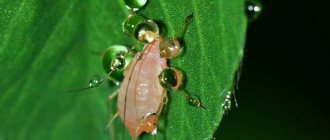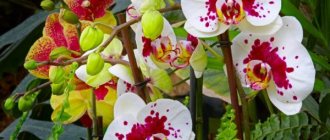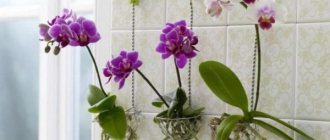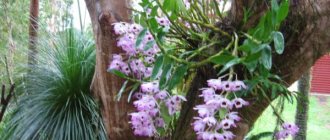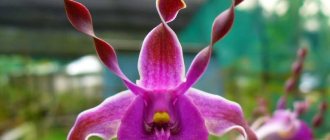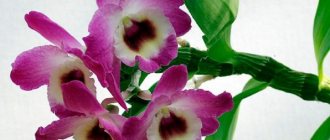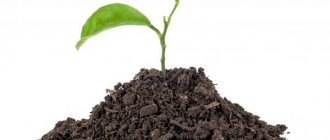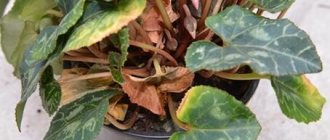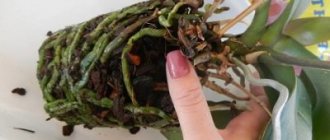The colony of greenish-black insects on the plant is hard to miss. Aphids on orchids, as well as on other indoor flowers, reproduce according to the principle of geometric progression. One adult female is capable of producing from 60 to 100 larvae per day, so the fight against this pest cannot be postponed until tomorrow. How to save an orchid from aphids?
Aphids belong to the order of hemipteran insects, numbering about 4 thousand species, of which about 1 thousand varieties are found in Europe. Most of them are malicious pests of plants, capable of not only destroying them by sucking out the juices, but also carrying dangerous viral diseases and causing various gall-shaped growths.
Varieties of aphids that attack indoor orchids
Aphids are a huge superfamily of hemipteran insects, including about 4 thousand species. Of these, three species can be found on indoor orchids:
- Greenhouse aphid (also known as green peach or tobacco aphid). It lives in the southern regions of Russia, in places where there are peach orchards. The peach tree is the primary host of this aphid species, where the first 2-3 generations of the colony hatch. Then the winged female migrants fly to secondary hosts, which include orchid plants. Most often found on dendrobiums, vandas, and cattleyas.
- Orchid aphid. It is found on orchid farms and in large greenhouses, where it is carried by ants. It parasitizes mainly on coelogines, but can also reproduce on other orchid species.
- Beet aphid (aka bean aphid). In Russia it is widespread. Differs in dark body color. Orchids can get through windows from bushes of euonymus, jasmine, viburnum, from thickets of quinoa, thistle, or simply from the garden. Prefers cymbidiums, dendrobiums and phragmipediums.
The signs of aphids on orchids are the same as on other plants. A settled colony is usually easy to notice with the naked eye. These are small insects, 2-3 mm in length, green, brown or black, accumulating on the underside of leaf blades or on the tops of peduncles. The leaves and trunk of the orchid themselves become contaminated with sticky secretions - honeydew, to which dust, larval skins and aphid excrement stick. On the upper side of the leaf blades, yellow dots may be observed, formed at the sites of punctures by the aphid's mouthparts.
Important! Aphids are sucking parasites that feed on the cell sap of orchids. But that’s not the only thing that’s dangerous. Aphids are capable of infecting plants with viral and fungal infections, which are very difficult to get rid of.
Aphids destroy not only the vegetative organs of orchids. It colonizes the tips of flower shoots, sucking juices from the buds, spoiling flowers and buds.
Types of aphids
Several types of aphids love orchids :
- Buraya;
- Green;
Aphids come in a variety of colors.
- Black;
- Yellow;
- White;
- Red.
Identifying the species is very difficult due to the fact that there are about 800 species of this insect, but do not worry about the diversity. All our recommendations are suitable for exterminating any species. The most popular is the white aphid. In the photo above you can see what aphids look like.
Reasons for the appearance of aphids on orchids
Aphids can only get on indoor orchids from the outside:
- through windows, if plants are grown on window sills and loggias;
- on new specimens of orchids and other indoor plants, if quarantine is not observed;
- with bouquets of cut flowers or flowering branches of jasmine and euonymus.
Typically, infection occurs in the summer, when the air temperature is +240C and above. But with newly acquired specimens of orchids, aphids can “come” to the house in the colder season.
A number of factors contribute to the proliferation of aphid colonies:
- Nitrogen overfeeding of orchids. Fertilizers containing nitrogen, applied in excess, make the leaves large, but too juicy, with soft and loose underlying tissue. Such a vegetative mass often cracks, releasing juice, and is especially attractive to aphids, since even the larvae are able to get food from it.
- Excessive watering and spraying. High humidity in warm air is a necessary condition for aphid reproduction. Additionally, orchids that are watered and misted frequently produce soft, delicate leaves that are attractive to pests. Specimens grown with prolonged drying have dense, upturned foliage and are much less likely to be attacked by aphids.
Thus, the appearance and reproduction of aphids on orchids is largely facilitated by the incorrect actions of the grower himself.
While there are few aphids on the plant, insects can be noticed only by an indirect sign - traces of honeydew. Therefore, it is important to carefully inspect purchased young specimens and take timely measures to destroy pests.
What types of pests attack the flower?
Orchids are affected by different types of aphids: gray, black, white, brown, green, red and yellow.
Aphids primarily settle on the underside of leaves. The insects then spread along the stem and eventually reach the flowers, infecting the entire plant.
Attention! Aphids feed on the juices of the flower, thereby damaging its tissue. As a result, the leaves curl, the stem turns black, and the flower stalks dry out and fall off.
You can find out more about what aphids eat here. During their life, these parasites secrete sticky sugary secretions that cover the flower with a translucent coating. This liquid is very attractive to ants, with which aphids are in constant symbiosis (more information about the symbiosis of ants and aphids can be found here). Therefore, it is not surprising that when aphids appear, a whole army of ants will flock to the flower. You can learn more about the types of aphids from this material.
Chemical means of killing aphids on orchids
The most effective means of killing aphids are offered by the agrochemical industry. The only problem is choosing a drug that can be more or less safely used indoors. To control insects on indoor orchids, you can purchase one of the following insecticides:
| Name | Description | Mode of application |
| "Aktara" | A highly effective drug that kills aphids within 24 hours. Penetrates deeply into the leaves, maintaining a protective effect for almost a month after treatment. No cases of aphid immunity have been recorded. | For 2.5 liters of water, take 2 g of the drug and spray the leaves, trunk, peduncles and top layer of the substrate. |
| "Commander" | It works against both adults (adults) and aphid larvae. Does not have a pronounced odor. Destroys the colony in a few hours, the protective effect lasts for 2 weeks. | For 2 liters of water, take 1 ml of water-soluble concentrate and apply it by spraying. |
| "Tanrek" | An effective insecticide that destroys the colony within 24 hours. It has a pronounced systemic penetration into all organs and tissues of the plant, and maintains a protective effect for a long time. The smell is very weak and quickly disappears from the room. | Take 1 ml of the drug per 2 liters of water and apply it by spraying. |
Many other chemical insecticides are also highly effective against aphids, but not all of them are convenient to use in an apartment. For example, the excellent drug “Fufanon” has a strong odor that lasts for a long time, providing a fumigant effect, but is inappropriate in indoor conditions.
Tip #1. Even those insecticides that do not have a strong odor are best sprayed on the leaves, placing the orchid under a plastic bag. Experienced flower growers tie the bag for a few minutes after spraying so that the product works faster.
Aphids can crawl all over the orchid, even on the roots. Therefore, if possible, you need to spray the insecticide not only on the vegetative parts, but also on the root system of the plant.
What damage does aphids cause?
First, the parasite is located on the leaf blades of the orchid, then it moves to the stems, flowers and buds, since these areas are the most succulent.
Aphids feed on beneficial microelements that the plant needs in order for it to grow normally. Pests multiply extremely quickly and form many colonies that will be located where new leaf blades should grow. When an insect feeds, it releases toxic substances into the orchid, which disrupt the distribution of nutrients and photosynthesis. Areas that are infested with aphids become softer and then may die. If the insect is not controlled, the entire plant may die.
Folk remedies for controlling aphids on orchids
Many gardeners are afraid to use agrochemicals to control insects and prefer to cope with folk remedies. To treat orchids against aphids, you can use one of the following recipes:
- Take 1 tablespoon of laundry soap and dissolve in 1 liter of water. In the shower, wash off the aphids from the orchid and spray the leaves and trunk with soapy water. The recipe is suitable for orchids grown without substrate.
- Grind 1 onion with the peel in a meat grinder and pour in 1 liter of boiling water. After cooling, strain and treat the leaves and the top layer of the substrate through a spray bottle.
- Take a half-liter jar of dry onion peels, pour it into a deep saucepan and pour 1.5 liters of boiling water. Bring to a boil, turn off the heat, cover with a lid and wait to cool. After straining, rinse the orchid leaves with the infusion and pour out the substrate.
- Add 20 drops of tea tree oil to 300 ml of clean water and spray the orchid.
Folk remedies do not always help effectively cope with aphids. They have no residual effect, so if eggs or larvae remain in the substrate, after some time the colony can recover. Thus, home remedies can help only in the very early stages of orchid damage by insects.
Folk remedies for aphids do not have an eradicating effect. But they expel aphids from infected plants and repel them from uninfected ones, so they are suitable as a preventive measure.
Tips and preventive measures
To prevent damage to indoor orchids by aphids and other pests, you need to adhere to a number of preventive measures :
- In order for your orchid to please you for a long time, water it at certain hours and regularly, once a week. In winter and autumn you should water the flower less often than in summer;
- Do not allow the soil to dry out;
- Spray periodically, but pay attention that water does not collect on the leaves and in the flower bud;
Don't forget to spray your orchid periodically.
- Remember to constantly check the flower, especially the underside of the leaf;
- It is advisable to keep the flower that first entered your home separately from the rest for a week and regularly check for the presence of harmful insects;
- Maintain the orchid's fertilization system strictly . An excess or deficiency of elements such as iron or nitrogen greatly weakens plant immunity. Weakened orchids are an excellent target for aphids;
- When replanting, use only disinfected pots.
Attention! If during a routine examination you find white scales on the underside of the flower, this means that your flower is infested with aphids. Young individuals molt several times as they grow, leaving scales on the surface of the leaves.
Biological preparations for the control of aphids on orchids
The best option to combine the effectiveness of chemicals with the safety of folk remedies is biological insecticides. Their action is based on the use of natural toxins obtained from plant or microbiological raw materials.
The following bioinsecticides are well suited for killing aphids on orchids:
| Name | Description | Mode of application |
| "Lepidocide" | The drug is based on a crystalline complex of spores and toxins of the bacterium Bacillus thuringiensis. The action is intestinal. Once in the digestive system of aphids, the drug paralyzes the intestines and the insects die within a few days. They stop eating 3-4 hours after treatment. | Take 3 ml of the drug per 1 liter of water and use it to spray the leaves and roots of the orchid. |
| "Fitoverm" | The drug is based on the toxin aversectin C, secreted by the streptomycete fungus Streptomyces avermitilis. It acts intestinally and partly contactally, paralyzing aphids in a few hours. | Take 1 ampoule (2 ml) of the drug per 250 ml of water and use it to spray the leaves and roots of the orchid. |
| "Aktofit" | The drug is an analogue of “Fitoverma” based on aversectin C. Maintains a protective effect for 2 days. Does not cause development of resistance in aphids. | For 1 liter of water, take 8 ml of the drug and use it by spraying. |
Bioinsecticides work slower than chemicals, but have greater benefits. Even with constant use of the same drug, effectiveness is guaranteed. Insects do not develop resistance to biological poisons.
How to get rid of white aphids?
Fortunately, there are quite a few methods and means to combat these pests. You just need to not be too lazy to use them on time.
Mechanical method
To combat aphids, it is most effective to use appropriate preparations - there are quite a lot of them in stores. As a rule, if the gardener has not yet encountered this problem, there are no such remedies at hand. And help should be provided to the plant as quickly as possible.
In such cases, a simple method of pest control, called mechanical, will help. The following actions must be taken:
- collect spotted individuals and their larvae by hand and destroy them;
- rinse the flower thoroughly with warm water;
- It is advisable to use a soap solution.
Important! Water should not get into the axils of the leaves. It stagnates there and causes the plant to rot, which is especially attractive to pests.
After the procedure, the soil must also be disinfected. To do this, you need to lightly stir it and pour it with a solution of potassium permanganate.
Biological drugs
The latest invention to combat such pests. Insects are destroyed by a special type of bacteria, although not immediately, but gradually, over approximately one week.
The advantages of this method include:
- availability of spraying treatment;
- protective properties last up to 2 weeks;
- These drugs do not cause any harm to humans or pets.
Important! There is one drawback to biological drugs. Do not allow preparations of this type to come into direct contact with the flower: it may die.
Spraying is carried out from the bottom up starting from the leaves. The leaves are treated on both sides, and only then the solution is applied to the stem.
The most effective and widespread biological products include:
- Fitoverm - its effect begins after approximately 2 days and lasts up to 3 weeks;
- Entobacterin - starts working after 5 days, is especially effective at temperatures around +30 degrees;
- Confidor - the drug is produced in Germany and is highly effective; its effectiveness is noticeable a week after treatment;
- Akarin - also shows good results after a week, but does not work on all types of aphids.
It is advisable to duplicate the initial treatment after 2-3 weeks, then the result will be better. It is only important to strictly follow the instructions for use of the drug.
Chemicals
They are recommended for use in cases of severe infection. For greater effectiveness, solutions of this type should be used at intervals of 2 weeks.
Important! It is advisable to use the drugs alternately. They quickly become addictive to insects and cease to have a detrimental effect on them.
When treating plants with chemicals, be sure to use rubber gloves and a respirator. The procedure must be carried out outdoors.
There are several available and effective drugs:
- Aktara - acts on the nerve endings of the insect and leads to its almost instant death;
- Actellik - actively acts not only on the plant, but also in the soil, begins to destroy insects already in the process of spraying;
- Spark is one of the rare chemicals that is virtually harmless to humans and pets;
- Intavir disrupts the functioning of the nervous system of pests, causing them to quickly die.
According to the method of influencing parasites, chemicals are divided into several groups:
- intestinal enter the insect’s body through the juice of the treated plant;
- systemic ones kill aphids when they enter the intestines and directly onto the skin;
- contact ones act by contacting the insect itself.
It is believed that systemic and intestinal remedies are most effective. Contact ones are recommended to be used at the initial stage of infection.
Work plan for removing aphids from orchids
Having chosen a suitable means for combating aphids, the following treatment is carried out:
- An infected orchid growing in a pot is placed in a bathtub. The pot is tied with a bag so that no water gets into it, and the above-ground part of the plant is outside.
- The orchid leaves are washed with a shower, mechanically removing insects and honeydew from them.
- Untie the bag and lift it so that it now covers the leaves.
- The leaves and top layer of soil are sprayed with a diluted insecticide.
Orchids that are grown without a substrate are treated in the same way, with the exception of the first point of the plan.
At the same time, you should carry out preventive spraying of all indoor flowers from the rack or windowsill on which the orchid grew. Aphids easily migrate from one food plant to another. If you do not protect all the flowers, after a while you can find pests on neighboring specimens.
How to treat the soil and roots?
It is recommended to periodically, even for preventive purposes, water the plant with a solution of potassium permanganate, but if it becomes infected, this must be done. You can water the soil in the pot with a solution of biological preparations, but you should not treat the roots with chemicals. An infusion of onion peels helps a lot.
It happens that when orchids are transplanted, characteristic growths caused by aphid infestation are found on the roots. They must be removed immediately and the entire plant disinfected.
Reviews from flower growers about means of killing aphids
Dealing with aphids on orchids is not difficult if you choose a product that takes into account the scale of the infestation. The experience of flower growers also confirms this:
“When I returned from vacation, I found my orchids completely covered with green aphids. All the flowers had fallen off, the flower stalks at the tops were directly covered with boogers. There was nothing at hand except milk and iodine. I sprayed it, but only made it worse. The number of insects did not decrease, but the orchids became dirty, all stained. I bought Fitoverm, trimmed the flower stalks, used cotton wool to remove all the aphids I saw from the leaves, and sprayed them. At the same time, I disinfected the window sill. Pests don’t come back” (Karina, Pskov).
How to identify pests
Aphids on orchids are a fairly common problem. Due to the capricious nature of the plant and improperly organized care, the flower’s immunity may be weakened, as a result of which it becomes easy prey for insects. The sooner the problem is identified, the less effort will have to be spent on eliminating it, and the less harm will be done to the orchid.
The following signs indicate the invasion and predatory activity of aphids:
- The appearance of scales on the underside of the leaves (this is the skin that insects shed as they grow);
- Curling and blackening of young leaves and shoots (usually aphids choose young shoots with fresh juice);
- The presence of small greenish bugs on the underside of the leaves (at first the back side of the leaf is colonized by aphids and only over time the colony moves to the front part).
Also evidence of a flower being damaged by a pest is the appearance of a sweet liquid on the entire surface of the plant. A sticky, shiny film covering the surface of the leaves not only worsens the appearance of the plant, but also prevents it from breathing fully. In addition, the sweet liquid, which is an integral product of aphids, can attract ants. Therefore, in the absence of timely measures, over time you will have to save the orchid not from one, but from two types of parasites.
Expert advice on preventing aphid infestations
Indeed, you can get rid of aphids quite quickly. However, pests weaken plants and make them susceptible to infections. Therefore, it is very important to take preventive measures to avoid infection:
“The rules of prevention are simply simple. Firstly, you need to observe quarantine - keep new specimens of orchids separately from the general orchidarium for two weeks. Secondly, you need to put mosquito nets on the windows. Thirdly, do not feed or overwater orchids. Fourthly, do not place bouquets of flowers near indoor plants.”
Yu. Lopatina, agronomist, orchid grower with 8 years of experience.
Processing rules
After detecting any type of insect, urgent treatment is necessary. Quarantine the plant.
A sick orchid, as well as all healthy plants, should be treated for preventive purposes in the following way:
- Using a cotton pad moistened with water, remove insects from the leaves and trunk of the plant if possible. Transplant the orchid into a fresh substrate, completely clearing the roots of the old one;
ADVICE! To remove the substrate more thoroughly, carefully rinse the roots under running water. Rinse Phalaenopsis and Vanda orchids entirely in the shower.
To prevent rotting of orchids after the water procedure, Vanda should be hung upside down until completely dry, and Phalaenopsis should be blotted with several dry cotton pads on the growing point and axils of the leaves. Leave dry cotton pads in your sinuses for 5 minutes.
- Dilute the preparation for treatment according to the instructions. Use only freshly prepared solution. Treat the plant and substrate evenly. Wet the leaves from the outside and inside;
- Repeat treatments until the pests are completely gone, but not more often than indicated in the instructions for the product.
Some folk remedies help:
- Repel pests;
- Slow down their reproduction.
You can use such means for prevention.
To make it easier to remove scale insects from the plant, use rubbing alcohol. They moisten cotton wool or a cotton swab with it and wipe away the accumulation of insects. Remember that some types of orchids are very sensitive to alcohol, so first you need to treat a small area of the leaf and make sure that there is no burn.
A solution based on laundry soap helps against aphids, thrips, and spider mites. It's easy to prepare. Dilute 30 grams of crushed soap in 1 liter of hot water, stir until completely dissolved. The plant is completely cooled and processed.
Tobacco infusion helps against:
- Thrips;
- Aphids;
- Fool.
Take tobacco dust or tobacco leaves, add hot water, the ratio of ingredients is 1:10. The solution is infused for 24 hours.
After this time, it is diluted with water 2 times and the plant is treated. For better viscosity, you can add 40 grams of laundry soap.
An infusion of citrus peels has proven well against:
- Mealybug;
- Aphids;
- Thripsov.
To prepare, take 100 grams of dry or fresh peels and add 1 liter of warm water. The solution is infused for 4 days, excluding exposure to sunlight. To enhance the effect, place dry peels on the surface of the substrate.
ATTENTION! An infusion of onion or garlic peels helps against most pests. Mix 100 grams of garlic peel in 10 liters of water, leave for 24 hours
To prepare onion infusion, you need 150 grams of onion peels.
In addition to the peel, you can use onion pulp. To obtain the mixture, the onion along with the husk is grated or passed through a meat grinder. The resulting slurry is poured with 1 liter of hot water. Leave for 2 days and filter. The resulting infusion is diluted with a liter of water and the plant is treated with it.
What to do for prevention?
To prevent aphids from infesting again, proper care of the plant is necessary:
- This parasite often appears in rooms with dry air. To prevent this, humidity should be at least 60%. Plus, such conditions are also beneficial for humans.
- Another important factor is watering. Water should not accumulate in the buds and between the leaves. It is best to use a spray bottle for watering.
- The most important rule is to take immediate action when the slightest sign of aphids appears. The fewer insects, the easier it will be to get rid of them.
Aphids are a serious problem for orchids, as this pest greatly damages the plant and can lead to its death. The most effective means of control are insecticides, but folk recipes can also be used if the flower is not yet severely affected.
Shchitovka
The scale insect that attacks phalaenopsis is a rapidly reproducing species of parasite and it usually appears on weak plants that are overfed with nitrogen. An insect can be of various types:
- palm scale;
- soft false scale;
- hemispherical pseudoscutellum.
These insects reproduce sexually and asexually, depending on the species. Male individuals can move from plant to plant, female individuals stick to the leaves with the help of a proboscis, feed on its juices and lay up to 2000 eggs. After the death of the mother, the larvae quickly spread to other plants.
Treatment
Treatment of scale insects is quite complicated, but possible. The natural enemy of the scale insect is good lighting and high environmental humidity. Therefore, in order to avoid the spread of the parasite, you should not just isolate the phalaenopsis, but even better, place it in a greenhouse.
Experienced gardeners recommend keeping the orchid in a greenhouse for 2-3 days, until the adults die and the young ones crawl out from under the mother’s shield. Next, we take the orchid out of the greenhouse and rinse it well under warm, running water, thus washing away the young insects.
Among the folk methods, the method of treating leaves with garlic pulp, as well as a soap-alcohol solution, has proven itself well.
However, here you should act with the utmost caution and apply these products exclusively to areas affected by scale insects
Chemical preparations for the treatment of scale insects have also proven themselves to be excellent:
- Contact insecticides: Permethrin.
- Intestinal: Aktara, Actellik, Arrivo.
- Systemic: Methylmercaptophos, Phosfamide.
Signs of infection
There are several ways in which pests appear on orchids. The most common is through a window. In summer, during ventilation, the insect enters the room through an open window and settles on the leaves of the plant crop. They can move from a neighboring pot, or the person himself can bring the pest into the house on clothes or shoes. You can find out that aphids have appeared on an orchid by the following signs:
- wilting of leaves;
- falling of flowers;
- deformation and twisting of sheet plates;
- the appearance of dark spots on the stem;
- the formation in some areas of the plant of a sticky transparent liquid - orchid secretion.
Only some time later, after individual elements of the plant have already died, can one notice the insects themselves, which abundantly cover the outer part of the plant crop, stem or flowers.
On a note!
It only takes 2 weeks for aphids to completely infect an orchid and lead to its inevitable death. At the same time, they reproduce extremely quickly; in just 1 clutch they leave from 30 to 40 larvae, which quickly grow to adulthood.
What kind of insect is this white and other color?
Aphids are insect pests that parasitize both outdoor and indoor plants. Aphids are small insects that parasitize plants. Eats juice. Belongs to the order Hemiptera. Previously, it was classified as a member of the order Homoptera.
What it looks like: description and photo
The maximum size of the parasite is 8 mm. Houseplants live on species whose size is approximately 0.5 mm. Appearance of aphids:
- The translucent body of the parasite has the shape of an ellipse, oval or drop.
- The color almost always matches the plant on which the insect parasitizes. There are green, pink, black, red and even transparent individuals.
- The head has a trapezoidal shape. It contains antennae consisting of segments. They are the organs of touch and hearing.
- The surface of the body is bumpy.
- The mouth is a small proboscis. With its help, aphids pierce the leaf and suck out the juice.
- There are 3 pairs of legs on the body with which it jumps.
- Aphids can be with or without wings. Everything depends on the conditions of existence. Both males and females have wings.
These insects are well organized. Each individual has its own role in the colony.
Below you can see a photo of the pest:
Kinds
There are several thousand species of aphids in nature. Most of them parasitize house plants. But most often you can find these types:
- Peach.
- Bakhchevaya.
- Green
Peach
Has a size of 2 mm. The color of the body changes depending on the plant on which it lives. The eyes are brown-red. The proboscis is straight, cylindrical, measuring 25% of the body. The tail is yellow. The eggs are oval and have a shiny black color.
Bakhchevaya
The size of the melon aphid varies from 1 to 1.9 mm. May be black, green or yellow. Paws and antennae are dark brown. This species forms very dense colonies on flowers.
Green
Green aphids are pale green in color. Has two spouts for sucking out juice. This species lays eggs on shoots. New flower buds eventually become food for the young.
Why is it dangerous?
Aphids on an orchid are a parasite that gradually destroys the entire plant. The pest is especially dangerous for the phalaenopsis variety - an aphid that appears on it will most likely completely destroy the flower.
It is necessary to get rid of it because:
- It multiplies very quickly and is capable of destroying an entire flower within two days if no measures are taken.
- In just a few hours, the aphid sucks out all the vital juices from the flower and the bush dries out.
- When the parasite enters the vegetative system, instead of the vital juices of the plant, it leaves a dangerous poison that blocks further access of beneficial substances from the nutritional part of the flower, so additional nutrition will not help in any way to cope with insects and restore the bush.
- The spread of poison throughout the flower causes the leaves to become sticky. This attracts insects that can destroy the entire orchid. The mucus traps bacteria and, as a result, the culture turns black, rots, and emits an unpleasant odor.
- Even if you manage to get rid of it, it quietly sheds its skin, from which new larvae later appear. It is necessary to treat the plant with a special product.
Please note! Fighting aphids on an orchid is difficult, because it must be done in a timely manner. Lost time can play a decisive role and lead to the death of the flower. Aphids do not eat fruits, but the idea that they are harmless to them is deceptive
Yes, it does not eat flowers directly. By sucking water, minerals, vitamins and microelements from the stems, it deprives the flowers of access to useful substances and the buds die. Among other things, it spreads harmful substances and infects the crop with viruses from other plants. Due to the substances released during the life process, aphids attract insects that eat the flower
Aphids do not eat fruits, but the idea that they are harmless to them is deceptive. Yes, it does not eat flowers directly. By sucking water, minerals, vitamins and microelements from the stems, it deprives the flowers of access to useful substances and the buds die. Among other things, it spreads harmful substances and infects the crop with viruses from other plants. Due to the substances released during the life process, aphids attract insects that eat the flower.
You may be interested in: What to do if all the leaves of an orchid have fallen off Amazing orchid flowers decorate interiors with their delicacy and variety of color combinations. There are more than 30…Read more…
